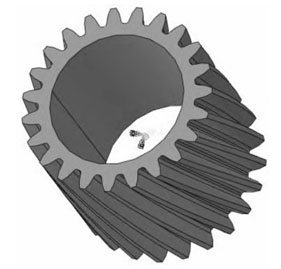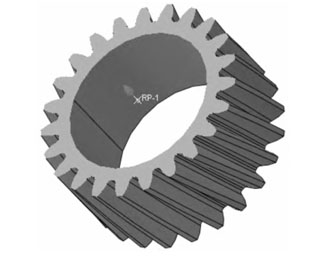Gear transmission is one of the most important forms of transmission in mechanical transmission, characterized by high efficiency, reliable performance, and stable transmission ratio. Its transmitted power can reach hundreds of thousands of kilowatts, making it widely used in various reducers and mechanical transmission systems. Compared with most mechanical parts, the design of gear mechanisms is more complex, involving dozens of structural parameters such as tooth number, pressure angle, center distance, etc. It also needs to consider load, working environment, and working condition parameters. During the design process, multiple factors such as tooth surface contact and tooth root bending need to be simultaneously met The strength criterion requires a large amount of calculation and extensive use of empirical formulas, making the design process complex and inefficient. Over the years, many scholars and engineering technicians at home and abroad have conducted extensive research on the digital design of involute cylindrical gear transmission, especially in the areas of parametric design and verification, achieving significant research results. According to the national standard for gear strength calculation, the verification calculations of planetary gear tooth surface contact strength and tooth root bending strength were implemented in MATLAB environment. We have studied the data processing and system construction issues in the parameterized design process of gear transmission, and researched and implemented the problems of data table processing and line graph expression in the design process, effectively improving the efficiency of gear design. Based on the principles of parameterization and modular design, various tables and line graphs in gear transmission design have been queried and extracted. A gear transmission design system with a good human-machine interface has been developed, effectively improving design efficiency and quality, and greatly reducing data query and calculation intensity in design work. Propose a self-service method for correcting the tooth surface of bevel gears, using NURBS surface fitting to construct the mean difference surface of the tooth surface. After correction, the deviation of the small wheel tooth surface is significantly reduced compared to before correction. In response to the problems of insufficient modeling accuracy and low design verification calculation efficiency, a parameterized design system for internal meshing gears based on precise tooth profile modeling was developed using MatlabGUI, effectively improving modeling accuracy and calculation efficiency.
The traditional gear design method adopts a large number of empirical formulas and chart data, approximates many influencing factors, and requires the use of safety factors to ensure strength, life, and reliability requirements. Therefore, the design results are too safe, leading to material waste and increased manufacturing costs, affecting equipment weight and overall performance. Therefore, it is necessary to optimize the gear structure using traditional design methods. With the development of optimization theory and computer numerical analysis technology, scholars at home and abroad have conducted extensive research on the structural optimization of gears and achieved fruitful research results. By analyzing the characteristics of chart data in traditional design, a programmatic method for data, tables, and line graphs in gear transmission design is proposed. With the development of optimization theory and computer numerical analysis technology, scholars at home and abroad have conducted extensive research on the structural optimization of gears and achieved fruitful research results. To solve the problem of nonlinear chaotic vibration generated during the operation of gear transmission systems, a chaos control scheme based on RBF neural network was proposed, and a mechanical transmission system with strong stability and robustness was obtained. The reliability optimization design method of single pole cylindrical gear transmission was discussed, and a reliability optimization mathematical model with volume as the objective function was established, and the implementation method was given. The software optimization toolbox has achieved structural optimization of a two-stage cylindrical gear reducer. In order to improve the meshing characteristics of multi axis high-speed gears under complex working conditions, considering elastic deformation and thermal deformation, with the goal of minimizing the unit normal load, the modification of multi axis high-speed gears was calculated and analyzed, and the optimal modification curves of each level of gears were obtained. Compared with domestic scholars, foreign researchers often consider other factors such as service life and dynamic load coefficient when dealing with gear transmission structure optimization problems. The genetic algorithm and particle swarm optimization algorithm were used to optimize the design of a multi-stage planetary gear system with the minimum volume as the objective function, and the optimal combination of design parameters for the minimum volume planetary gear system was found. A computationally efficient and effective gear design optimization method is proposed to improve the efficiency of gear design. By studying the optimization problem of macroscopic geometric gear design solved by genetic algorithm, with gear mesh stiffness and dynamic behavior as objective functions, the optimal method for minimizing dynamic excitation is obtained. Spiral tooth harmonic drive was proposed. Compared to the stress generated on straight teeth, the stress generated on spiral teeth of flexible splines is smaller. To achieve multi-objective optimization of the gearbox, genetic algorithm was used to optimize the design of pressure angle and helix angle. From the results obtained, it can be seen that multi-objective optimization using both micro and macro geometric parameters is different from the results obtained by using macro geometric parameters first and then micro geometric parameters.
The study focuses on the transmission optimization design of a two-stage involute cylindrical gear reducer. Based on the strength, size, and lubrication conditions of the gear, the objective function of the optimization problem is the minimum center distance. The study investigates the number of teeth, module, helix angle, high-speed gear ratio, low-speed gear teeth, and module of the high-speed small gear Multi objective optimization design of parameters such as number and helix angle.
The correct selection of optimization variables has a significant impact on the accuracy of the optimization scheme in the optimization process of a bipolar involute cylindrical gear reducer. When determining optimization variables, it is necessary to comprehensively consider the objective function and whether there is a correlation between each optimization variable. The number of teeth of gears is an integer variable while the modulus is a discrete variable. According to general nonlinear programming methods, both the number of teeth and modulus can be treated as continuous variables. After the optimization process is completed, the number of teeth and modulus of each level of gear can be rounded as necessary, and the strength can be rechecked. To ensure that the optimized results can still meet the strength requirements after rounding, the method of “upward rounding” is adopted for modulus rounding. The tooth width coefficient is regarded as a known variable that varies with the number of teeth or modulus during the optimization process, and is a derivative variable of the optimization variable, not directly used as an optimization variable.
In the design of involute cylindrical gear reducers, in addition to meeting necessary strength and interference conditions, the main goal is generally to have a compact structure and minimal volume. Therefore, the objective function of the two-stage involute cylindrical gear optimization problem is determined as the minimum total center distance to achieve the goal of minimizing the size.
Compared with the optimization problem of ordinary single-stage involute cylindrical gears, the structural optimization of two-stage involute cylindrical gears is more complex, with higher requirements for constraint conditions, and many factors need to be considered simultaneously. When optimizing the structure of the two-stage involute cylindrical gear reducer, the constraints considered mainly include satisfying the strength condition, size condition, and limiting conditions of various optimization variables. Among them, the strength condition and size condition constitute the performance constraint conditions, while the constraint conditions of each optimization variable serve as the boundary constraint conditions.
Through the analysis of the constraints on tooth surface contact strength and tooth root bending strength, it was found that gear stress is ultimately related to the original parameters such as the number of teeth, modulus, and helix angle of the gear. In each iteration process of the gear structure optimization problem, if the main parameters such as tooth number, modulus, and helix angle are used as optimization variables, the values of each coefficient in the strength constraint condition will change with the change of the main parameters after each iteration is completed. The updated constraint conditions will participate in the next iteration process, and the iteration will be repeated until the convergence condition is met.


